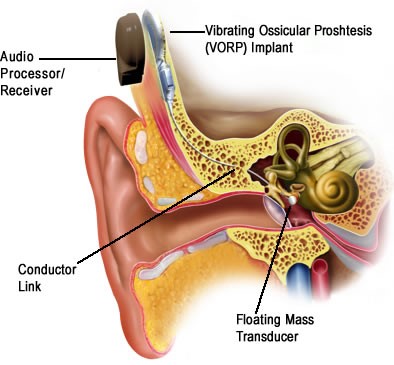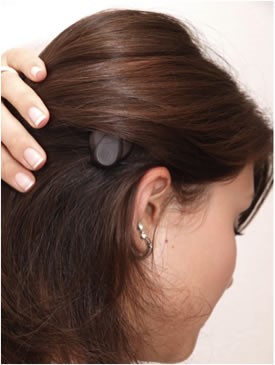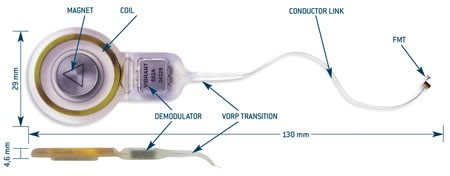What Is It?
The Vibrant® Soundbridge® is an FDA approved, direct-drive, semi-implantable middle ear device intended to provide a level of useful sound perception to individuals with a moderate-to-severe sensorineural hearing loss.
How it Works
The Soundbridge converts sound into mechanical energy that is directly transferred to the middle ear bone (auditory ossicles). Direct-drive means that the implant converts sound energy directly into mechanical energy to directly drive the inner ear.
The Soundbridge brings sound very close to the inner ear (cochlea) and, therefore, maximizes mechanical coupling to the inner ear to improve the clarity of sound transmission. Nothing is worn in the ear canal and the Soundbridge is 100% digital.
The Vibrant® Soundbridge® is considered a semi-implantable device because there is both an internal (implanted) component and an outer or external component.
- The internal component consists of two parts.
- The internal component placed directly under the skin behind the ear is known as the Vibrating Ossicular Prosthesis™ (VORP™).
- The second portion of the internal component is the Floating Mass Transducer™ (FMT™). The FMT™ attaches to the incus and vibrates the stapes bone. (See photo below)
- The outer or external component is known as the Amadé Audio Processor. The Audio Processor contains a microphone that picks up sound from the environment and transmits it across the skin to the internal receiver in the VORP™. The signal is then delivered to the Floating Mass Transducer™ through a wire, which causes the FMT™ to vibrate. The FMT™ mechanically stimulates the auditory ossicles, mimicking the natural hearing process. (For more photos of the Vibrant® Soundbridge®, please see the bottom of the page)

Vibrant® Soundbridge® Implant System

Amadé Audio Processor
Advantages
A direct drive system provides mechanical energy directly to the ossicles, bypassing the ear canal and the tympanic membrane. The Floating Mass Transducer™ of the Soundbridge mechanically stimulates the ossicles, mimicking the natural hearing process. This eliminates many of the inherent issues of conventional hearing aids such as occlusion, feedback, discomfort, and the need for ear wax-related repairs.
It also provides a measurable improvement in sound quality and clarity. Many patients also report improvement in noisy environments compared to conventional hearing aids.
Who It Helps
- Adults, 18 years of age or older
- Moderate-to-severe sensorineural hearing loss
- Unsuccessful with, or medically unable to wear, conventional hearing aids. (Prior to receiving the device, it is recommended that an individual have experience with appropriately fit hearing aids.)
- Normal middle ear function
Overview of Surgical Procedure and Postoperative Care
The internal device is surgically implanted during an outpatient (same day) surgical procedure. The procedure is conducted under general anesthesia and takes 1 1/2 to 2 hours to complete. The VORP™ is implanted under the skin in back of the ear, and the FMT™ is attached to the long process of the incus during the procedure. The middle ear structures are not modified. Therefore, there is no significant impact on the residual hearing of the patient. The risks of surgery are similar to that of routine ear surgery. After a few days of rest, the patient can resume normal activities.
Eight weeks after the procedure, the patient is fitted with the external audio processor that attaches magnetically in back of the ear. The patient’s audiologist then performs the fitting, programming and ongoing care of the audio processor.

Vibrating Ossicular Prosthesis (VORP Internal Implant